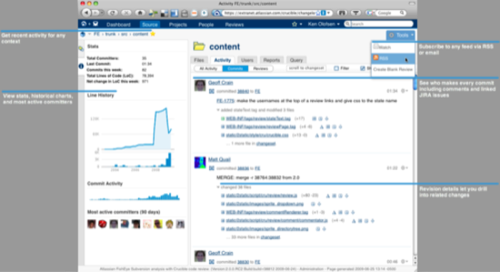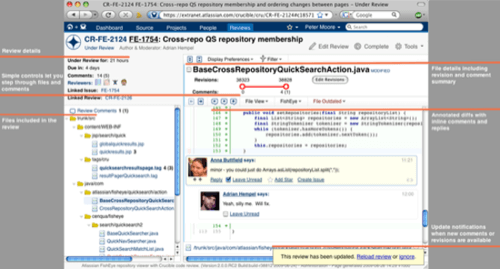This month, Atlassian launched the 2.0 versions of Crucible and FishEye, their collaborative software for coders. For those who’re unfamiliar, FishEye is a browser for source code repositories, and Crucible is a tool for peer code reviews.

Both have had a complete UI makeover that shines, but despite a strong track record from Atlassian, there are some critical flaws. FishEye’s new activity streams and profiles are valuable, but they’re overshadowed by how cluttered and counter-intuitive Crucible’s iterative code review system is.
FishEye 2.0
FishEye 2.0 is a lot more than just a browser for source code repository. It’s become a comprehensive dashboard for viewing and analyzing progress on a development project.
New activity streams show commits, JIRA issues, and Crucible reviews. There’s also fresh focus on individuals and projects, with impressive statistical charts to track what’s going on.
Still, tracking all the stats on commits and other activity is a value proposition that’s going to appeal to those managing teams, not those actually doing the work. Instead of the slick new capabilities, the biggest boost to adoption of FishEye is likely to be the beta support for Git, the version control system.

Crucible 2.0
Some of the changes to Crucible will be welcome improvements. Small things like keyboard shortcuts, highlighting of unread comments, and better integration with JIRA are all sure to make the lives of developers easier.
But the core of the product, code reviewing, is problematic in the new “iterative review” user interface. In short, it’s anything but intuitive to do diff by diff comparisons. At this point, free and open source alternatives like the Google-made Rietveld for Subversion, or Review Board present a simpler way to do side-by-side comparisons. That’s regrettable, considering that how valuable Crucible is when used alongside FishEye and JIRA.

Code is Law
Talking with developers about their strategies for code review, we discovered that most aren’t particularly hungry for complex platforms to do the job. If flashier aspects of a review tool hamper the ability to get quick feedback in any way, then you’ve got software that’s not worth using.
There’s no doubt Atlassian practices what it preaches when it comes to agile development. But the new features they’ve incorporated take the focus off code and put it on people and metrics. No matter how well-executed, that’s a fundamental problem of strategy that tars the software.










